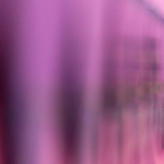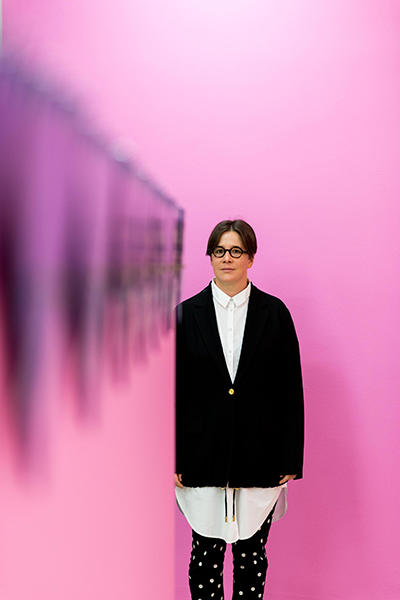
Radcliffe Fellow, interdisciplinary artist and writer Every Ocean Hughes shares thoughts on making art and queering art. She will be the featured artist at a free lunch for undergrads on Oct. 18.
By Truelian Lee '21
Earlier this week, I had the most fascinating conversation with Every Ocean Hughes, a multidisciplinary artist who’s a Radcliffe Fellow this year. At the end, I walked out of her office feeling like my brain had just exercised, as if my neurons were aching from being stretched and messaged. Like her art, Hughes’ answers were thoughtful and deep and probing. As someone who takes a more intellectual stance toward art, I was interested in so clearly seeing someone else approach art in that same analytical, self-conscious way. At one point in our conversation, Hughes was describing her artistic philosophy and said that a portion of it “would be hard to describe in your vocabulary.”
“I like to generate vocabulary and contribute that through my work to my community and to anybody. That’s kind of the work I feel like I’ve been doing,” Hughes said.
Hughes will be a featured guest artist 12-1 p.m. Friday, October 18 during ArtsBites, the Office for the Arts series that combines artists, undergraduates, food and conversation around the big table at 74 Mount Auburn Street. The event is free and open to all undergraduates, but registration is required.

The following are edited and condensed highlights from my conversation with Hughes.
How did you come up with the idea to focus on “queer death”? What inspired you?
I have been living a life with death my whole life. A few of my best friends died when I was very young, so it’s been a very consistent thing in my life, and as I grew older, I knew that one day, I would deal with it, that I would take this content and really look at it. But also, as an artist and a thinking person and a person in the queer community, I have always been very attuned to the fact that a generation of people died in the AIDS crisis before I moved to New York. In that way, I am also in tune to how the community has been deeply and profoundly affected and formed by that experience. One of the other things about queer death: If you use “queer” like “to queer something” – like “queering” death – what that really means to me is that I’m bringing it back to the body. I’m very interested in the aesthetic experience of dying. I also think about the way we’re looking at death in these times of violence and precarity and rising fascism, how we’re reading about it and seeing it in the news. I wanted to put all those things together. In a way, it is the most intimate personal project I’ve ever done in that it has more of me in it, but the things that I do always are trying to be relevant and in a political context.
You mentioned earlier in our conversation that you had started to use the term “queer death” to describe your work less. What is the thought process behind this evolution?
I’m an artist who asks questions. I get a lot of pleasure from and I’m very invested in vocabulary, in what tools we have to articulate ourselves, especially coming from a queer community, and a community that has codes and also has invented language, that needs language, that has wanted more from language than what is available to it. I lived in Stockholm, Sweden, for the last six years full time and I was teaching there, and it’s my experience there that makes me question the term “queer” and the saturation of “queer.” I won’t say acceptance, because I don’t think that’s what it is. It’s commercial saturation. And things have changed. A lot of things have changed for the better. People can live more genders with more styles and people get to live rather than not live. In terms of how we use the word “queer,” I’m interested in being more specific. I love it. I still use it all the time, and I think it’s a beautiful word. Historically, it’s an important word, and I think it’s also vernacular in the way that it can signify a broad, broad range of things, and that is always fun. I have absolutely zero interest in policing “queer” anything, but I am interested in what it does and how that’s changed.
You recently released Help the Dead, a live performance that focuses on self-determination, accountability and continuity. In what ways does it differ from your previous works?
When I was younger, I didn’t have the tools to deal with that. I don’t think anyone would. But now I was old enough, I started to deal with it, and it became an emotional project, a spiritual project, an art project, and for me, it is a political project. Help the Dead is a different work for me because for the first time, I am not performing in the work, and it’s also scripted completely. I’m enjoying it. It’s not proper theater, but it’s very textual. It’s also a story. I’ve never told a story before. For the first long bit of being an artist, I was thinking through movement, aesthetically, experimentally, socially, politically, so I was really interested in things like the way we organize ourselves, what that looks like, the history of representation in social movements, and also things that are more abstract. I was working a lot with abstraction and identity.
As an artist, you have a lot of experience working with abstraction. Do you have any advice to give to Harvard students who are similarly interested in working with abstraction and turning it into art?
It’s always within a certain person’s personality and skills and desire. It’s very hard to say a kind of generalized thing, because an approach to an artwork is entirely you. It’s how you think and how you feel and what you want from the world.